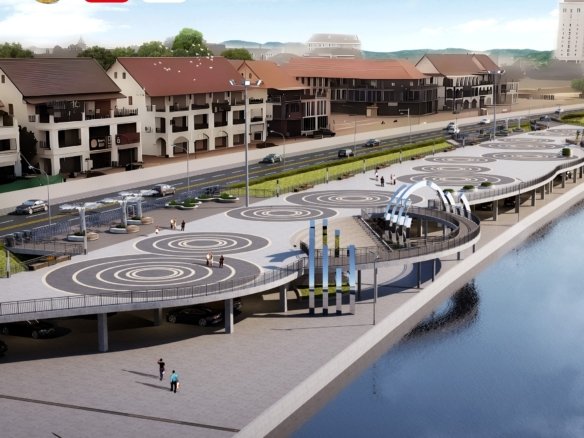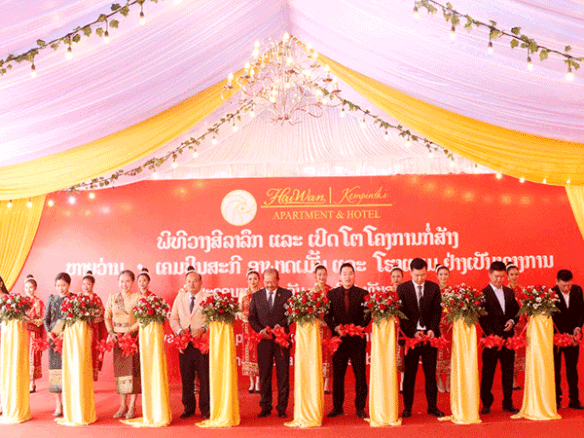
By Ian MacKinnon, Financial Times
When developers proudly promise their efforts will shortly transform the sleepy Lao capital of Vientiane into a Hong Kong on the Mekong river, the future looks bleak for the city’s dwindling roster of French colonial villas that grace the tree-lined boulevards.
Vientiane, perched on a bend of the Mekong, is the little sibling of a trio of historical cities of French Indochina (1887-1954) that includes Phnom Penh and Ho Chi Minh City, formerly Saigon. The communist rulers, who took power in 1975 following a civil war, have maintained a degree of economic and cultural isolation. While this has hobbled development, it has also helped to ensure that Vientiane’s wide avenues, laid out in classical French style, have mostly survived.
Sixty years have passed since the colonial French left, however, and time is taking its toll. Some of the mansions once occupied by the French and Laotian elite are crumbling from neglect. In the recent rush for development, others have fallen to the wrecker’s ball.
A few villas have been restored sensitively, often with help from abroad. For more than 20 years, US textiles expert Carol Cassidy, 56, has leased and renovated the only colonial villa in private hands. Every detail of the 1920s house, which is set in a leafy garden in downtown Vientiane, has been carefully considered. Putty to replace missing windows had to be brought from Thailand because it was not available locally, for instance, and paints had to be mixed precisely to match the shutters’ original colour. Today the gleaming whitewashed stucco, framed by Lao-style eaves pointed with carved Naga heads, contrasts with the carmine red roof tiles.
When the government opened the economy to foreign investment in 1986, Cassidy applied for a licence to form Lao Textiles, which aimed to reinterpret the country’s ancient weaving tradition. In 1990, she established the first private company in the Lao People’s Democratic Republic, using the villa both as a family home and a workshop. Today Cassidy’s self-styled “social enterprise” employs 50 people working 28 looms, filling orders from London, Tokyo and New York among others. Cassidy recently exhibited the company’s work at the Textile Museum in Washington, DC.

Carol Cassidy’s restored 1920s Lao-French villa
“This is our home. We’ve lived and worked in this space for the past 24 years,” says Cassidy. “This house has a lot of history and I believe in respecting the past.”
Saffron-robed monks ambling between central Vientiane’s stunning gold-roofed Buddhist temples add to the timeless atmosphere. Other well-kept colonial villas are dotted around as well, such as the restored National Library of Laos and the mansions behind the high walls of the French embassy compound.
On Avenue Lane Xang, Vientiane’s equivalent of the Champs-Elysées (sporting its own triumphal arch, the Patuxay Monument), lies one of the city’s best collections of colonial buildings. With some restored and some rebuilt to original specifications, they conjure Vientiane’s past and possible future. The leased buildings are home to the local headquarters of two of neighbouring Thailand’s biggest banks (Siam Commercial and Krung Thai), as well as the Asian Development Bank.
Foreign investment in new hydroelectric dams, mineral mining and agribusiness projects contributed strongly to the country’s 8 per cent economic growth last year. And much of the new wealth has flowed into Vientiane itself where land prices (and house prices, to a lesser extent) have accelerated in the past two to three years.
Rapid development is particularly noticeable in the Sikhottabong neighbourhood, a few kilometres west of the city centre. The district is home to the international airport and has become a new business and residential area. In a riverside setting, a recently-built traditional Lao-style property with three bedrooms and a large garden is on sale through local agents Lao Land Company for $400,000.

Buoyed by a number of large mall and mixed-use developments under construction, land prices across Vientiane rose by an average of 15 per cent in 2012 over the previous year, according to Houmphan Salyalath, of estate agent RentsBuy.com. But along the Mekong, particularly in the Sisattanak district favoured by embassies, businesses and NGOs, land prices leapt 50 per cent.
Although reliable figures can be hard to come by, Houmphan says house prices remain flat or have increased only slightly and sales are often slow. RentsBuy.com, for example, has been marketing a four-bedroom house in Sisattanak at $250,000 for more than four years.
Part of the reason for sluggish sales and static house prices even in the face of rising land prices, says Somthip Boualaphone, managing director of agents Immo-Laos, is that Lao people tend to prefer to buy a plot and build their own property. Land prices are also being boosted by speculation, especially by overseas buyers who use Lao nominees to circumvent a ban on foreign land ownership. “Many Chinese, Vietnamese and South Korean people buy in the name of a Lao person,” he says. “Even though it’s against the law, they keep doing it.”
Foreign ownership restrictions deter many expatriates from buying in Vientiane but Thounkeo Sibounheuang, of Lao Land Company, says she is seeing increasing numbers of people from France, Switzerland and the US – drawn by the city’s relaxed charm, low property prices and cheap living costs – coming to buy retirement homes. “They’re buying houses from Lao owners on 30-year leasehold agreements,” she says, “with the contractual arrangement that if the law changes they’d be able to buy outright.”
One property that might appeal to budget-conscious retirees is a two-storey, Lao-style house with wooden balconies around the upper floor. The three-bedroom, three-bathroom home in the Hadxaifong district is marketed through Immo-Laos for $165,000.
——————————————-
Buying guide
● Foreigners can only buy property on a leasehold basis and for a maximum of 30 years
● Average daytime temperatures range from 28C in December to 34C in April
● Rental income from leased land and property is taxed at 15 per cent
What you can buy for . . .
$100,000 A single-storey, three-bedroom house on a 417 sq metre plot in the Xaysetha district
$500,000 A three-bedroom wood and concrete house in Sisattanak, near the Mekong
$1m A five-bedroom house with large garden in Hadxaifong neighbourhood
Copyright The Financial Times Limited 2013.






